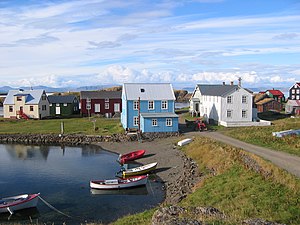Flatey (Breiðafjörður)
| Flatey | ||
|---|---|---|
| Flatey | ||
| Waters | Atlantic Ocean | |
| Geographical location | 65 ° 23 ′ N , 22 ° 55 ′ W | |
|
|
||
| Illustration from the Flateyjarbók | ||
Flatey is the largest island in the Breiðafjörður fjord in Iceland .
The island is populated and a stopping point for a ferry that crosses the fjord from south to north and goes from Stykkishólmur on the Snæfellsnes peninsula to Brjánslækur in the ( West Fjords ).
history
The community of the same name ( isl. Flateyjarhreppur ) was incorporated into Reykhólahreppur in July 1987 .
The settlement history of the island goes back to the time of the conquest, when, according to Landnámabók, a certain Þrándur mjóbeinn took possession of the islands west of Bjarnareyjarflói. Since then, the island has been continuously inhabited and also an important trading center, which is documented from 1777.
In 1172 a monastery was founded on the island, but it was transferred to Helgafell (Helgafellssveit) near Stykkishólmur as early as 1184 . However, it still left visible traces on the island today. For example, names such as Klaustarhólur refer to the former location, and even the holy water bowl is supposedly still visible as a so-called Klaustursteinn .
In the first half of the 20th century, many people still lived on Flatey, which at that time u. a. had to have his own doctor. On January 1, 2011, 10 residents were still registered in Flatey. In summer, however, the owners of summer houses and tourists also come.
Literature and film
The island is famous as a center of Icelandic culture, and that is primarily literature. Medieval manuscripts from the 14th century are Flateyjarannáll and the manuscript Flateyjarbók , of which the annals are a part. The Flateyjarbók is one of the most famous medieval Icelandic manuscripts, the collective manuscript of many sagas. It was not written on the island, but was temporarily kept there, and that is how it got its name. In the 17th century it came into the possession of Brynjólfur Sveinsson , the then Bishop of Skálholt , who gave it to the Danish king. She only came back to Iceland in 1971.
Even in the 19th century, Flatey was still an important place of culture and a. because of the publication of an influential magazine there and one of the first public libraries in the country.
Flatey is also the setting of the crime novel The Riddle of Flatey by Icelandic author Viktor Arnar Ingólfsson . The Icelandic original of this book is called Flateyjargáta . The novel, set in 1960, refers to the Flateyjarbók manuscript.
Flatey has served as a backdrop for films several times, including the television series Nonni and Manni . The album Flatey by Lovísa Elísabet Sigrúnardóttir , named after the island, was released in 2009 by Cod Music on CD & DVD.
See also
Web links
Individual evidence
- ↑ Íslandshandbókin. Náttúra, saga og sérkenni. 1. bindi. Edited by T. Einarsson, H. Magnússon. Örn og Örlygur, Reykjavík 1989, 207
- ↑ Íslandshandbókin. Náttúra, saga og sérkenni. 1. bindi. Edited by T. Einarsson, H. Magnússon. Örn og Örlygur, Reykjavík 1989, 207f.
- ↑ Íslandshandbókin. Náttúra, saga og sérkenni. 1. bindi. Edited by T. Einarsson, H. Magnússon. Örn og Örlygur, Reykjavík 1989, 208
- ↑ a b c Íslandshandbókin. Náttúra, saga og sérkenni. 1. bindi. Edited by T. Einarsson, H. Magnússon. Örn og Örlygur, Reykjavík 1989, 208
- ^ Hagstofa (Stat. Office of Iceland) (Icelandic); Accessed September 7, 2011
- ↑ Flateyjarbók. Retrieved January 18, 2016 .
- ↑ Sigurður Líndal: A Little History of Iceland
- ^ Lay Low - Flatey , Discogs, accessed July 4, 2018


